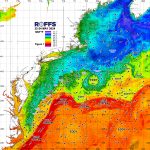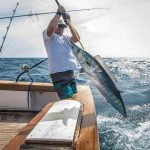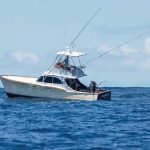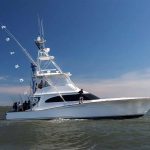Updated Videos on ROFFS™.com – Be Sure to Check Out the “Hot News” Button on the ROFFS™ Homepage
We Need a Bigger Boat

Approximate weight 160 kg. Video Courtesy: Better Videos Fishing | Facebook
Please click HERE to watch the video on our website now!
Blue Marlin chases Yellowfin Tuna behind Wani Kanati, Harbour Island, Bahamas

Captain Rich Hellmuth on the Wani Kanati Sport Fishing Yacht off the coast of Harbour Island Bahamas works Blue Marlin as it chases a yellow fin tuna the way a kitten chases a ball of yarn. Video credit to Deborah Hellmuth. Video Courtesy: Jennifer Messier | YouTube
Please click HERE to watch the video on our website now!
Huge Fish!

Huge Grouper like fish caught at Mayaro, Trinidad. Video Courtesy: ENT! BREAKING NEWS | Facebook
Please click HERE to watch the video on our website now!
Blue Marlin Onboard!

Another ripper day onboard Mufasa Sportfishing during the Blue Marlin Bash off the Gold Coast, Queensland with a Blue Marlin jumping into the back of the boat and just about tagging the decky. Luckily no one was injured and 10 points to the Mufasa Sportfishing crews commitment. Video Courtesy: Mufasa Sportfishing | Facebook
Please click HERE to watch the video on our website now!
Yacht on FIRE!!

Have you ever seen a sadder video?? Video Courtesy: Boat Krazy | Facebook
Please click HERE to watch the video on our website now!

Please click HERE to watch the video on our website now!
How to Remove a Hook!

Please click HERE to watch the video on our website now!
Seakeeper In Action!

Please click HERE to watch the video on our website now!
Updated Client Photos

Please click HERE to our newly updated 2016 client photo gallery on our website now!
Bahamas Season Fishing Forecast for 2016: LOOKING VERY GOOD SO FAR
Since 2003 we have been developing objective methods for forecasting the overall fishing action during the April-June Bahamas Billfish Championship (BBC) tournament season. The hypothesis for forecasting the seasonal marlin fishing action stems from the location and geographic extent of the bluer and often warmer water that occurs from the Cat Island – San Salvador Island area and south where it is presumed that the marlin concentrate before, during, and after spawning. We have been calling this water “blue marlin water.” From satellite data it is relatively easy to identify this water based on its signature optical and surface water temperature characteristics. Our working hypothesis is that the marlin are associated with this water and the more “blue marlin water” that exists in the Abaco Islands and Eleuthera Island areas, the greater the relative apparent abundance of marlin in these areas. Also in recent years we have observed an association between this water and the yellowfin tuna action in the Bahamas, as well as, along the western side of the Gulf Stream between Jacksonville, Florida and Cape Hatteras, North Carolina. This also seems to be holding true for the canyon areas northeast to Massachusetts when the blue water is brought to the edge of the continental shelf (100 fathoms/600 feet) starting in April. But as this article is focused on the blue marlin and the Bahamas, the discussion related to yellowfin tuna and bigeye tuna, the overfishing off west Africa, changes in dissolved oxygen, and catch rates off the United States east coast will have to wait for another article as we have time over the next few weeks and months.
Based on our observations of the fishing action and ocean conditions in the Bahamas, particularly from Eleuthera to the Abacos over the last 20+ years it appears that excellent fishing action overall occurs within the BBC tournament area when there is a substantial volume of the “blue marlin water” pushing over the 100 fathom (600 feet, 200 meters) and shallower ledges along the eastern side of Eleuthera and the Abacos. Relatively good fishing seasons occur when this water only occurs over the 500-1000 fathom depths, but does not reach the 100 fathom and shallower depths of both areas. Mediocre years occur when there is a lack of this water over these areas. Short pulses of this water bring fish into the area along with pulses of fishing action. However, unless the flow is persistent, the catch rates remain so-so over the longer term.

Above: Figure 3 (left hand side) was derived from a variety of infrared sensors on NASA, NOAA, JPSS and ESA satellites during March 11, 2016 and Figure 4 was derived from the ocean color imagery during March 11 & 13, 2016 from the VIIRS sensors on SNPP satellites respectively. We consider this an image pair.
Please click here to view the full 2016 forecast on our website now!New Website Explores National Effort to Better Understand Marine Life, Ecosystem Change
Article Courtesy: oceanservice.noaa.gov
U.S. monitoring network zeroes in on marine biodiversity as an indicator of change in the ocean.
The U.S. Marine Biodiversity Observing Network (U.S. MBON), an effort to improve our understanding of changes and connections between marine biodiversity and ecosystems, recently launched a new website. In addition to exploring the vision and themes of the network’s demonstration projects, the site offers profiles of projects in progress and outlines future goals for data integration, animated seascape mapping, and technology applications such as new methods for genomic sampling and analysis.
Biodiversity is the proverbial “canary in the coal mine” and can be an early indicator of change in the ocean—for better or for worse—provided it’s noticed. By building a comprehensive network, researchers and decision-makers hope to better understand how ecosystems are changing, more accurately forecast long-term trends, and plan for events like harmful algal blooms. U.S. MBON brings together experts in remote sensing, genomics, ecology and biogeochemistry, and data management to define and monitor ocean variables essential for studying ecosystem, biodiversity, and oceanographic conditions over time.

Above: Biodiversity Benchmark – Marine biodiversity can be an early indicator of change in the ocean, provided it’s noticed. The U.S. Marine Biodiversity Network aims to ensure that scientists not only notice changes in biodiversity, but also have the tools in place to better understand what these changes tell us about ocean health over time. Kelp forests within Monterey Bay National Marine Sanctuary, shown here, are part of the observation network.
Please click here to read more on the new website which explores the national effort to better understand marine life & ecosystem change on our website now!
NOTICE: AL – DAUPHIN ISLAND – Naval Testing
Commencing approximately March 28, 2016 and continuing until approximately April 16, 2016, the Naval Research Laboratory will deploy research equipment at 6 mooring locations. The planned locations of the moorings are in approximate positions:
Mooring (1), 30-10-28.16N 088-01-07.57W
Mooring (2), 30-10-57.00N 088-04-40.51W
Mooring (3), 30-12-03.49N 088-07-22.15W
Mooring (4), 30-07-46.13N 088-07-23.09W
Mooring (5), 30-03-06.80N 088-07-18.91W
Mooring (6), 29-58-40.01N 088-07-16.00W
Mooring (1) will extend 2 feet off bottom. Moorings (2) and (3) will extend with a line to just below the ocean surface. Moorings (4), (5), and (6)
will extend with a line to 30-foot below surface. Nine inch in diameter white buoys with a flashing yellow 2.2s, light characteristic will be deployed to mark these subsurface moorings. Mariners are asked to not disturb these experiments and are urged to use caution when transiting the area.
Backlash? Feedback?

As always, please send comments & feedback on Fishy Times newsletter content directly to us at feedback@roffs.com.
If you do not want to wait for our next Fishy Times newsletter, please visit us in the meantime to get all your fishing news on Facebook, Instagram, Twitter, YouTube and on the web. Safe and successful fishing until next time!






